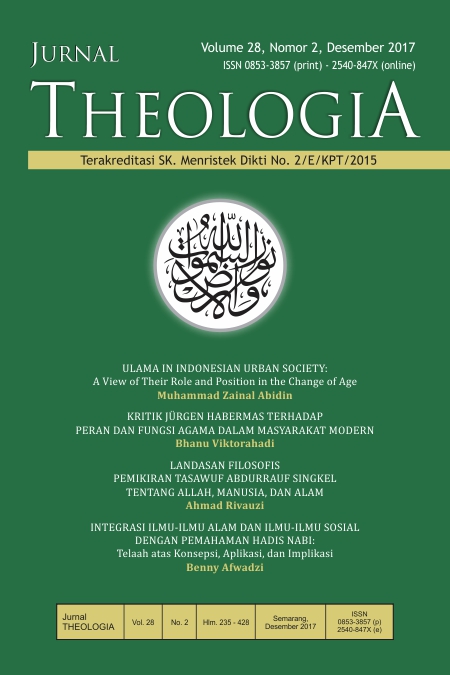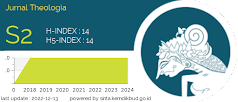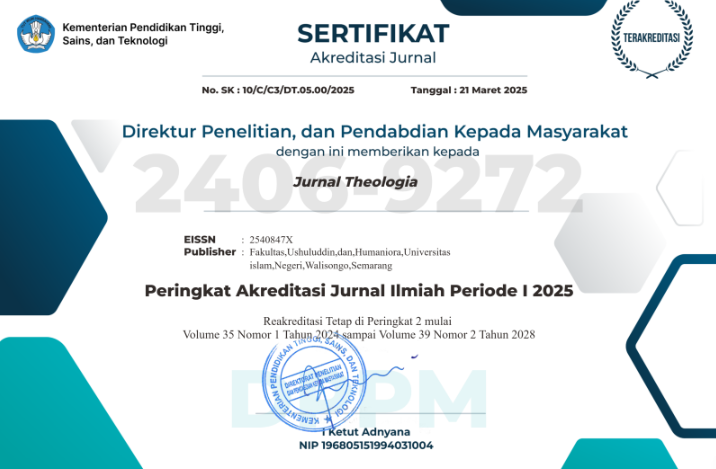DISKURSUS MUNĀSABAH: Problem Tafsīr al-Qur’ān bi ’l-Qur’ān
DOI:
https://doi.org/10.21580/teo.2017.28.2.1443Keywords:
munāsabah, tafsīr bi ’l-ma’thūr, tafsīr al-Qur’ān bi ’l-Qur’ānAbstract
Abstract: Munāsabah al-Qur’ān is a part of ‘Ulūm al-Qur’ān which presents pros and contrast. The pros ulama makes munāsabah as a method to reveal enigma system of Quran verses and chapter. The structure of the Quran’s verses and chapters seems to leap and are not connected each other. But for ulama who are contra to munāsabah, this success considered as a subjective product which did not put munāsabah tafsīr as ḥujja tafsīr automatically. As a questionious Quran’s knowledge, munāsabah has become a tafsīr method al-Qur’ān bi ’l-Qur’ān (textual relations in the Quran) which is in the highest position in the hierarchy of tafsīr bi ’l-ma’thūr with the highest ḥujja (a binding proof) status. Quranic exegesis is called ma’thūr if it is based upon the traditions of the Prophet, his Companions, and the immediate Successors of the Companions. The active subject as athīr in the tafsīr bi ’l-ma’thūr is the prophet in the tafsīr al-Qur’ān bi ’l-Ḥadīth; Companions in the tafsīr al-Qur’ān bi aqwāl al-ṣahāba; and tābi’īn ‘the immediate Successors of the Companions’ in the tafsīr al-Qur’ān bi aqwāl al-tābi’īn which the explanation or behavior is athar which is made as the base (ma’thūr) of the interpretation. But what about the exegesis of al-Qur’ān bi ’l-Qur’ān: is Allah as the active subject or a Quranic naṣ? If Allah, of course, he delivers it through the prophet and it belongs to tafsīr al-Qur’ān bi ’l-Ḥadīth category. If Allah analogically through al-Qur’ān naṣ truly, so does this al-Qur’ān naṣ automatically become the base of another al-Qur’ān naṣ or it still needs the help of an interpreter? This question becomes an epistemological problem of tafsīr al-Qur’ān bi ’l-Qur’ān through the helping knowledge, it is munāsabah al-Qur'an. The formulation of the problem in this paper, firstly, how the method of munāsabah operates in the al-Qur’ān bi ’l-Qur’ān interpretation. Secondly, what is the impact of the munāsabah method works on the status of the al-Qur’ān bi ’l-Qur’ān interpretation. The result, firstly, the method of munāsabah used to explain one verse against another, is ijtihādy; and secondly, it affects to the ma’thūr and ḥujja status of the al-Qur’ān bi ’l-Qur’ān interpretation which has been getting the top spot in the hierarchy of interpretation bi ’l-ma'thūr so that necessary reformulation Quranic interpretation bi ’l-ma'thūr.
Abstrak: Munāsabah al-Qur’ān termasuk bagian dari ‘Ulūm al-Qur’ān yang mengundang pro dan kontra. Ulama yang pro menjadikan munāsabah sebagai metode untuk mengungkap enigma sistematika ayat dan surat al-Qur’ān. Sepintas susunan ayat dan surat melompat-lompat dan dirasakan tidak saling terhubung. Tetapi bagi ulama yang kontra munāsabah, keberhasilan tersebut merupakan produk subjektif yang tidak serta merta menempatkan tafsir-tafsir munāsabah sebagai tafsir ḥujjah. Sebagai ilmu al-Qur’ān yang dipersoalkan, munāsabah telah menjadi metode tafsīr al-Qur’ān bi ’l-Qur’ān yang secara hirarkis menempati posisi teratas tafsīr bi ’l-ma’thūr dengan status kehujjahan tertinggi. Suatu penafsiran disebut ma’thūr bila disandarkan kepada al-Qur'an sendiri, hadits atau sunnah Nabi, qaul Sahabat, dan Tabi’in. Subjek aktif sebagai athīr pada tafsīr bi ’l-ma’thūr adalah Nabi pada tafsīr al-Qur’ān bi ’l-Ḥadīth; Sahabat pada tafsīr al-Qur’ān bi aqwāl al-ṣahābah; dan tābi’īn pada tafsir al-Qur’ān bi aqwāl al-tabi’īn yang keterangan atau tindak perilakunya adalah atsar yang dijadikan dasar (ma’thūr) penafsiran. Tetapi bagaimana dengan tafsīr al-Qur’ān bi ’l-Qur'ān: apakah Allah sebagai subjek aktifnya atau naṣ al-Qur'an? Kalau Allah, tentu melalui Nabi dan itu berarti masuk kategori tafsīr al-Qur’ān bi ’l-ḥadīth. Kalau Allah (secara majāzī) melalui naṣ al-Qur’an secara haqīqī, maka apakah naṣ al-Qur’an ini menjadi dasar penafsiran naṣ al-Qur’an yang lain dengan sendirinya atau dengan bantuan penafsir? Pertanyaan ini menjadi problem epistemologis tafsīr al-Qur’ān bi ’l-Qur’ān melalui ilmu bantunya yaitu munāsabah al-Qur'an. Rumusan masalah dalam tulisan ini pertama, bagaimanakah metode munāsabah beroperasi dalam tafsir al-Qur'an dengan al-Qur'an. Kedua, apa dampak cara kerja metode munāsabah terhadap status tafsīr al-Qur’ān bi ’l-Qur’ān. Hasilnya, pertama, metode munāsabah yang dimanfaatkan untuk menjelaskan satu ayat terhadap ayat yang lain, bersifat ijtihādī; dan kedua, karena itu berpengaruh terhadap status kema’tsuran dan kehujjahan tafsīr al-Qur’ān bi ’l-Qur’ān yang selama ini mendapatkan tempat teratas dalam hirarki tafsir bi ’l-ma’thūr sehingga diperlukan reformulasi tafsir bi ’l-ma’thūr.
Downloads
References
Abduh, Muḥammad, Tafsīr al-Qur’ān al-Ḥakīm al-Mushtahar bi Ism Tafsīr al-Manār, Kairo: Dar al-Manar, 1947.
al-’Akk, Khālid ‘Abd al-Raḥman, Uṣūl al-Tafsīr wa Qawā’iduh, Beirut: Dar al-Nafāis. 1986.
al-Biqā’ī, Burhān al-Dīn Abi al-Hasan Ibrāhīm bin ‘Umar, Nadhm al-Durar fi Tanāsub al-Āyāt wa al-Suwar, Kairo: Dār al-Kitāb al-Islāmī, . t.th.
Badr, ‘Abd Allah Abd al-Saud, Tafsīr al-Ṣahābah, Beirut: Dar Ibn Hazm, 2000.
al-Dzahabī, Muḥammad Husayn, al-Tafsīr wa al-Mufassirūn, Kairo: Maktabah Wahbah, 2000.
________, ‘Ilm al-Tafsīr. Kairo: Dār al-Ma’ārif, t.th.
Gheitury, Amer dan Arsalan Golfam, “The Qur’an as a Non-Linear Text: Rethinking Coherence,” Jurnal Humanities, Vol. 15, No. 1 (2008).
al-Hāji, Muḥammad Umar, Mausū’ah al-Tafsīr qabla ‘Ahdi al-Tadwīn, Damaskus: Dar al-Maktabi, 2007.
Kemenag RI, LPMQ, “Qur’an Kemenag” (OS Android), Jakarta: LPMQ, 2016.
Khajehei, Hassan, dan Alireza Shakarami, “An In-depth Linguistic Analysis of the Thematicconnectivity in the Holy Quran,” Savap, Vol. 2, No. 2, March 2012.
Khalīfah, Ibrāhim ‘Abd al-Raḥman Muḥammad, al-Dakhīl fi ’l-Tafsīr. Mesir: Dār al-Kutub, t.th.
al-Rāzī, Muḥammad Fakhr al-Dīn, Mafātiḥ al-Ghayb. Beirut: Dar al-Fikr, 1981.
al-Rūmī, Fahd bin ‘Abd al-Raḥman bin Sulaymān, Buhūth fi Uṣūl al-Tafsīr, Riyadh: Maktabah al-Tawbah, t.th.
al-Suyūthī, Abu al-Faḍl Jalāl al-Dīn ‘Abd al-Raḥman Abū Bakr, Tanāsuq al-Durar fi Tanāsub al-Suwar, ed. ‘Abd al-Qādir Aḥmad ‘Aṭa, Libanon: Dār al-Kutub al-’Ilmiyah, 1986.
________, al-Itqān fi ‘Ulūm al-Qur’ān, Madinah: Majamma’ al-Malik al-Faḥd li Ṭabā’ah al-Mushaf al-Syarīf, 1426 H.
Shihab, M. Quraish, Kaidah Tafsir: Syarat, Ketentuan, dan Aturan yang Patut Anda Ketahui dalam Memahami Ayat-ayat al-Qur'an, Tangerang: Lentera Hati, 2013.
________, Studi Kritis Tafsir al-Manar Karya Muḥammad Abduh dan M. Rasyid Ridha, Bandung: Pustaka Hidayah, 1994.
al-Ṣibā’ī, Musthofa, al-Sunnah wa Makānatuha fi al-Tasyrī’ al-Islāmī, Beirut-Damaskus: al-Maktabah al-Islamiyah, 1978.
Said, Hasani Ahmad, “Diskursus Munāsabah al-Qur’ān: Menyoal Perdebatan Otentisitas al-Qur’ān,” Al-Dzikra: Jurnal Studi Ilmu al-Qur’ān dan al-Hadits, Vol. 5, No. 9 (2011).
Taymiyah, Ibn, Muqaddimah fi Uṣūl al-Tafsīr, ed. ‘Adnān Zarzūr, Kuwait: Dār al-Qur’ān al-Karīm, 1972.
Yusuf H.M, Mohd., “Munasabah dalam al-Qur’an: Suatu Kajian tentang I’jaz al-Qur’ān),” Jurnal Tajdid, Vol. XI, No. 2 (2012).
Ṭālib, ‘Alī bin Abi, Nahj al-Balāghah, Beirut: Dar al-Ma’rifah, t.th.
al-Ṭayyār, Musā’id bin Sulayman, Fuṣūl fī Ushūl al-Tafsīr, Riyādh: Dar Ibn al-Jawzī, 1999.
al-Wāhidī, Abu al-Hasan Ali bin Ahmad bin Muḥammad bin Ali, Asbāb al-Nuzūl, Riyadh: Dar al-Maiman, 2005.
YBM-BRI, Al-Qur’an: Tafsir Perkata Tajwid, Depok: Riels Grafika, 2015.
al-Zarkasyī, Badr al-Dīn Muḥammad bin ‘Abd Allah, al-Burhān fi ‘Ulūm al-Qur'ān. Juz 1. Tahqiq Muḥammad Abu al-Faḍl Ibrahim. Kairo: Dar al-Turats, t.th.
al-Zarqāni, Abd al-Aẓim, Manāhil al-Irfān fi ‘Ulūm al-Qur'ān, tahqiq Fawwaz Aḥmad Zamarli, Beirut: Dār al-Kitāb al-’Arabī, 1995.
Zayd, Nasr Ḥamid Abu, Mafhūm al-Naṣ: Dirasah fi ‘Ulūm al-Qur’ān, Beirut: al-Markaz al-Tsaqafi al-’Arabi, 2014.
Zainal Arifin M. “Mengenal Jumlah Hitungan Ayat dalam al-Qur'an”, http://lajnah.kemenag.go.id/artikel/134-mengenal-jumlah-hitungan-ayat-dalam-al-Qur’ān





















